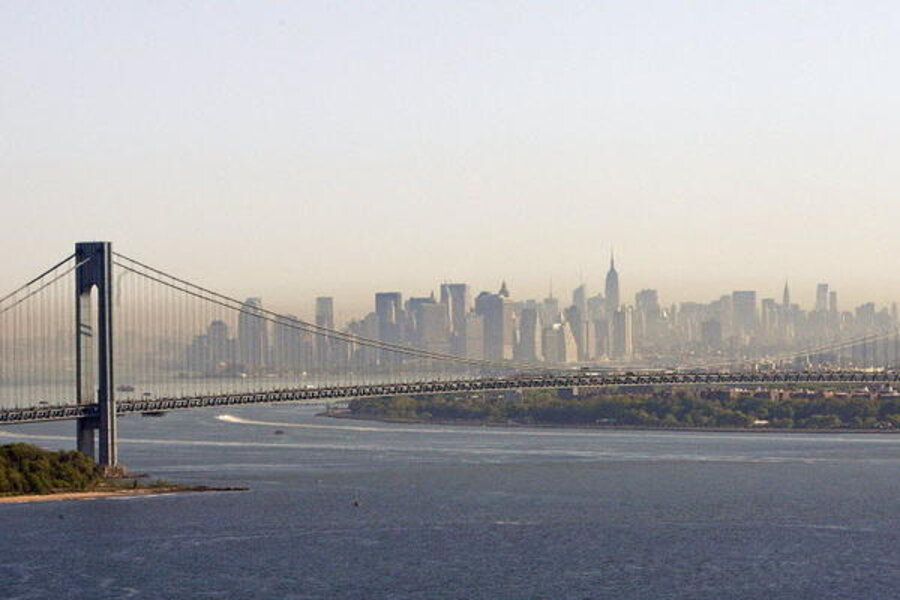Smog check: EPA proposes tougher regs for ground-level ozone pollution
In a controversial move that could impact the US economy as well as the health of millions of Americans, the Obama administration wants to tighten ground-level ozone pollution standards.
Environmental and health advocates welcome the proposed improvement in standards for what is commonly known as smog. Industry groups say tightening such regulations would result in “enormous costs” to the economy, jobs, and consumers.
Specifically, the Environmental Protection Agency (EPA) wants to strengthen air quality standards for smog to within a range of 65 to 70 parts per billion (ppb) in the atmosphere, while considering arguments for lowering the level to 60 ppb.
Under the Clean Air Act, EPA is required to review such standards every five years. The last review (2008) set the standard at 75 ppb.
As described in the EPA’s announcement Wednesday, “Ground-level ozone forms in the atmosphere when emissions of nitrogen oxides and volatile organic compounds ‘cook’ in the sun from sources like cars, trucks, buses, industries, power plants and certain fumes from fuels, solvents and paints.”
Typically associated with urban and industrial areas, smog is found in less-populated places in the West where gas and oil is extracted, and winds have carried it into national parks.
Although it can make for more dramatic sunrises and sunsets in some areas where smog concentrates, ground-level ozone also is associated with asthma, heart problems, and other medical difficulties.
As with many environmental issues, federal regulatory agencies are tugged in opposite directions by outside experts and interest groups.
In June, the EPA’s Clean Air Science Advisory Committee expressed concern that “although a level of 70 ppb is more protective of public health than the current standard [75 ppb], it may not meet the statutory requirement to protect public health with an adequate margin of safety.”
“The recommended lower bound of 60 ppb would certainly offer more public health protection than levels of 70 ppb or 65 ppb and would provide an adequate margin of safety,” this group of outside scientists wrote to EPA Administrator Gina McCarthy.
Gretchen Goldman, a lead analyst in the Center for Science and Democracy at the Union of Concerned Scientists (UCS), points out that the EPA clean air advisory group first recommended the 60 to 70 ppb range in 2007. “I’m glad to see a proposed standard that would finally be more protective of Americans’ health,” Dr. Goldman writes on the UCS web site.
Industry groups were quick to push back against proposed lowered standards for ground-level ozone.
“Tightened standards could impose unachievable emission reduction requirements on virtually every part of the nation,” Jack Gerard, president and CEO of the American Petroleum Institute (API), said in a statement.
“Even pristine areas with no industrial activity such as national parks could be out of attainment,” Mr. Gerard said. “Needless to say, operating under such stringent requirements could stifle new investments necessary to create jobs and grow our economy. The right policy choice is to implement the current standards and allow air quality to continue to improve.”
API estimates the annual cost of compliance at $270 billion and 2.9 million jobs.
“Manufacturing growth could slow or stop in states that find themselves unable to meet a lower ozone standard,” the American Chemistry Council warned. “In these ‘nonattainment’ areas, facilities face regulatory requirements that make projects far more costly and complex. Most likely, companies wanting to expand or build a facility will be forced to shut down operations elsewhere or find the significant additional investment required to buy emission offsets.”
Industry-friendly lawmakers were quick to pounce as well.
“EPA’s proposed tightening of ozone standards threatens to put large swaths of the country into non-attainment and could be the costliest regulation in US history, which would be devastating to the economy,” Sen. Lisa Murkowski (R) of Alaska, senior Republican on the Energy and Natural Resources Committee, said in a statement.
“Yet again we’re seeing the Obama administration release an incredibly expensive regulation on the eve of a major national holiday,” Senator Murkowski said. “The administration is clearly hoping to release this at a time when the vast majority of Americans are focused elsewhere, and that alone should tell us something about it.”
In an online op-ed column written for CNN, EPA Administrator McCarthy disputed the economic argument against stiffening ozone standards.
“Missing work, feeling ill, or caring for a sick child costs us time, money, and personal hardship. When family health issues hurt us financially, that drags down the whole economy,” McCarthy writes. “The good news is that if these proposed standards were finalized, every dollar we would invest to meet them would return up to $3 in health benefits (totaling up to $38 billion in 2025, and going up from there).”
“When EPA revised ozone standards in 1997, critics claimed ‘new air quality regulations … will destroy jobs, hike business costs, and exact painful lifestyle changes while doing little to improve health.’ None of that ever came true,” McCarthy writes. “Of the counties that didn't meet the 1997 standard back then, 90 percent now comply. Overall, since 1980, ozone pollution has decreased 33 percent nationwide. Simply put, the United States has never had to choose between a healthy economy and a healthy environment and we won't start now.”









